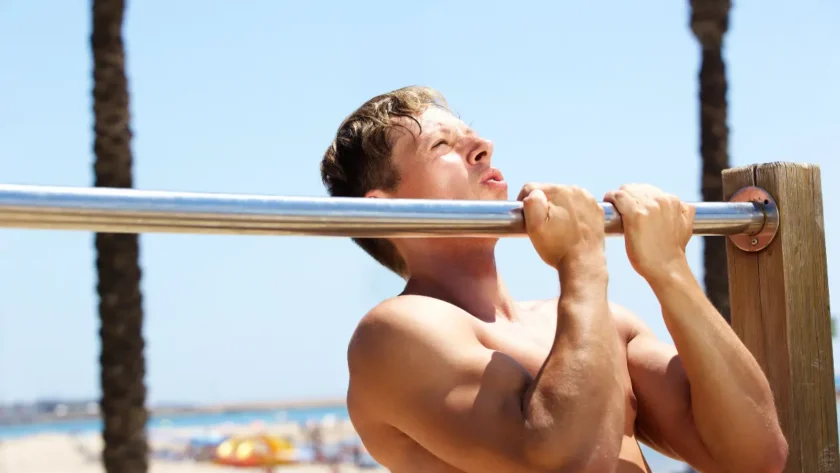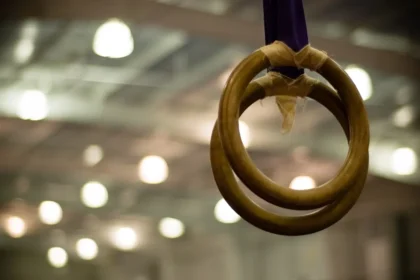Close grip chin-ups, a demanding variation of the classic chin-up, challenge even seasoned fitness enthusiasts. This exercise targets the upper body with laser-like precision, emphasizing the inner lats, biceps, and forearms.
For those seeking to break through plateaus and sculpt a more defined upper body, close grip chin-ups offer a potent addition to any workout regimen.
Contents
Introduction to Close Grip Chin-Ups
Close grip chin-ups are performed by gripping a chin-up bar with your hands closer together than shoulder-width, typically about 6-8 inches apart. This hand position is narrower than a standard chin-up grip, which alters the muscle engagement and difficulty of the exercise.
Key Characteristics:
- Hand Position: Hands are placed close together on the bar, often shoulder-width apart or less.
- Grip Type: Typically performed with an underhand (supinated) grip, unlike pull-ups which use an overhand grip.
- Movement: The body is pulled up until the chin clears the bar, then lowered back down in a controlled manner.
- Elbow Position: During the movement, elbows stay closer to the body compared to wide grip chin-ups.
How They Differ from Other Chin-Up Variations:
- vs. Wide Grip Chin-Ups: Close grip chin-ups target the inner lats more and involve even more bicep activation.
- vs. Pull-Ups: While both engage the back muscles, close grip chin-ups with an underhand grip put more emphasis on the biceps.
- vs. Neutral Grip Chin-Ups: Close grip chin-ups typically use a supinated grip, which changes the angle of pull on the lats and biceps.
Why Use Close Grip Chin-Ups?
Close grip chin-ups are great for anyone wanting to build upper body strength, especially in the biceps and inner back muscles.
They’re also a good option for people who feel that wide grip chin-ups put too much stress on their shoulders, as the close grip is easier on them.
How Close Grip Chin-Ups Work the Muscles
Close grip chin-ups are a compound exercise that engages multiple muscle groups simultaneously. The narrower hand placement alters the biomechanics of the movement, affecting muscle recruitment and activation patterns.
Here’s a breakdown of how close grip chin-ups work for different muscle groups:
Latissimus Dorsi (Lats):
The latissimus dorsi, or lats, are the primary muscles worked during close grip chin-ups. These are the large, flat muscles that span across the back and are responsible for the “V” shape often desired by athletes.
The close grip variation particularly engages the inner portion of the lats, which helps in building thickness in the upper back rather than just width.
Biceps Brachii:
One of the most significant differences between close grip and wide grip chin-ups is the increased engagement of the biceps. The close grip chin-up places more load on the biceps, making it an excellent exercise for those looking to improve arm strength and size.
The closer hand placement forces the biceps to do more work in lifting the body, which can lead to greater muscle hypertrophy in this area.
Forearms and Grip Strength:
The forearms are heavily involved in close grip chin-ups due to the need for a strong grip on the bar.
The brachioradialis, a muscle of the forearm, is particularly engaged, and the exercise helps in developing grip strength, which is beneficial for other lifts and functional activities.
Trapezius and Rhomboids:
These upper back muscles are crucial for stabilizing the shoulder blades during the movement.
The trapezius, particularly the lower part, and the rhomboids are activated to help control the shoulder girdle as you pull yourself up and lower yourself down, contributing to better posture and upper back strength.
Pectoralis Major (Chest):
While primarily a back exercise, the close grip chin-up also involves the lower part of the pectoral muscles. These muscles assist in the movement, particularly at the top of the chin-up, where the chest comes closer to the bar.
Core Muscles:
The rectus abdominis and obliques are activated to stabilize the torso throughout the movement. This core engagement helps prevent swinging, ensuring that the movement is controlled and that the target muscles are effectively worked. This makes close grip chin-ups a good compound exercise for overall core strength as well.
How to Perform Close Grip Chin-Ups
Performing close grip chin-ups correctly is crucial for maximizing muscle engagement and avoiding injury. Here’s a step-by-step guide on how to do them:
Step-by-Step Instructions
1) Grip the Bar:
- Stand under a chin-up bar and grasp it with your palms facing toward you (supinated grip).
- Position your hands about 6-8 inches apart, narrower than shoulder-width. This close grip focuses on the biceps and inner lats.
2) Hanging Position:
- Hang from the bar with your arms fully extended. Your body should be straight, with your legs either slightly bent or crossed at the ankles to prevent swinging.
- Engage your core by pulling your navel toward your spine. This stabilizes your torso and prevents unnecessary movement.
3) Pulling Up:
- Begin the upward motion by depressing your shoulder blades (scapular retraction) and pulling your elbows down toward your ribs.
- Continue pulling until your chin is above the bar. Focus on engaging your biceps and lats throughout the movement.
- Avoid swinging or using momentum; the motion should be controlled and smooth.
4) Lowering Down:
- Slowly lower yourself back to the starting position by extending your arms fully.
- Control the descent to maintain tension in the muscles, particularly the biceps and lats.
5) Repetition:
- Repeat the movement for the desired number of repetitions, maintaining proper form throughout.
Key Tips for Proper Form
- Avoid Swinging: Keep your body as stable as possible. Swinging can reduce the effectiveness of the exercise and increase the risk of injury.
- Focus on Muscle Engagement: Concentrate on using your biceps and lats to pull yourself up rather than relying on momentum.
- Breathe: Inhale as you prepare to pull yourself up and exhale as you pull your chin over the bar.
Common Variations
- Pull-Ups: Similar to close grip chin-ups, but with your palms facing away from you (pronated grip). This variation decreases bicep engagement and increases focus on the back muscles.
- Assisted Close Grip Chin-Ups: Use a resistance band or an assisted chin-up machine if you’re unable to perform full repetitions on your own.
In conclusion, close grip chin-ups elevate the traditional chin-up to new heights of effectiveness. This variation not only helps build strength and muscle but also contributes to a more defined upper body, better posture, and enhanced overall pulling power.




